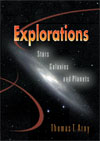Our picture of the Universe has been assembled bit by bit from many separate discoveries made by scientists from many parts of the world, at
many times in the past, and in many disciplines. How those discoveries led to
our current knowledge is the subject of this chapter. For convenience in our
discussion, we will divide the history of Western astronomy into four main periods
that can be characterized as follows: Prehistoric (before 500 B.C.): In the prehistoric era, people observed the
daily and seasonal motions of the Sun, Moon, and stars and learned to use their
cyclic motions for keeping time and determining direction. Classical (500 B.C.-A.D. 1400): In the classical period, scientist-philosophers
began to make measurements of the heavens and, with their knowledge of geometry,
constructed idealized models that could account for the motion of heavenly bodies. Renaissance (A.D 1400 - A.D 1650): In the Renaissance period, those geometrical
models were reassessed and found wanting. Astronomers therefore devised new
models that took into account a much greater body of data based on observational
records accumulated over centuries. Astronomers also benefited from a technological
advance that allowed them to observe even more --the telescope. Modern (A.D. 1650 to the present): Finally, in the modern period, scientists
began the search for the physical laws (such as the Law of Gravity) that underlie
the observed movements in the heavens. Other important contributions to our
understanding of the Universe came from technological advances (for example,
in optics, electronics, and computers) and better mathematical techniques (such
as calculus). Such factors continue to be important today. | 


 2002 McGraw-Hill Higher Education
2002 McGraw-Hill Higher Education